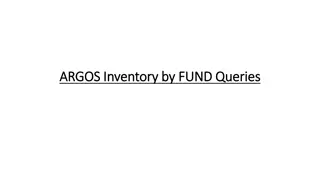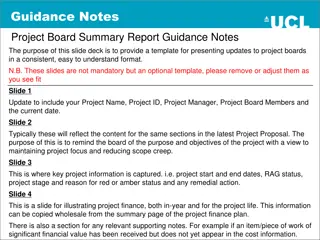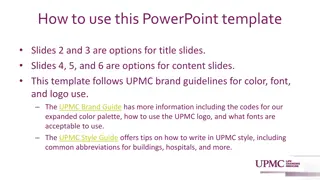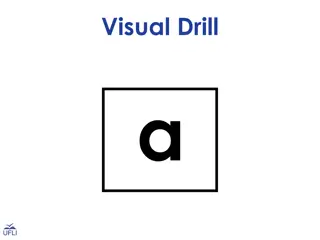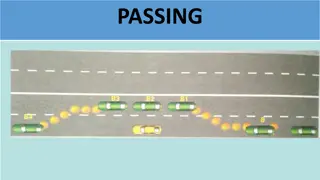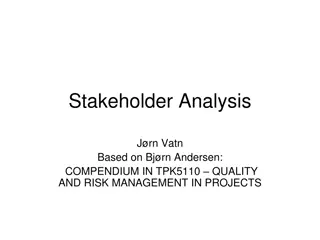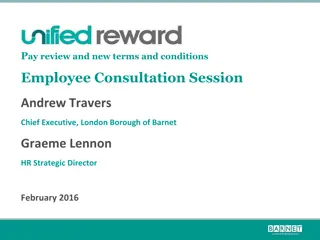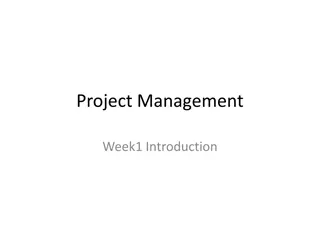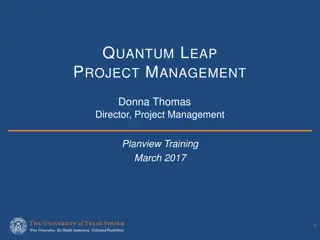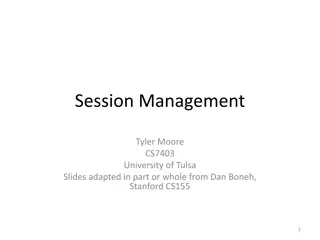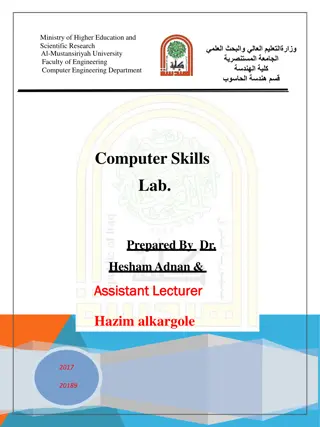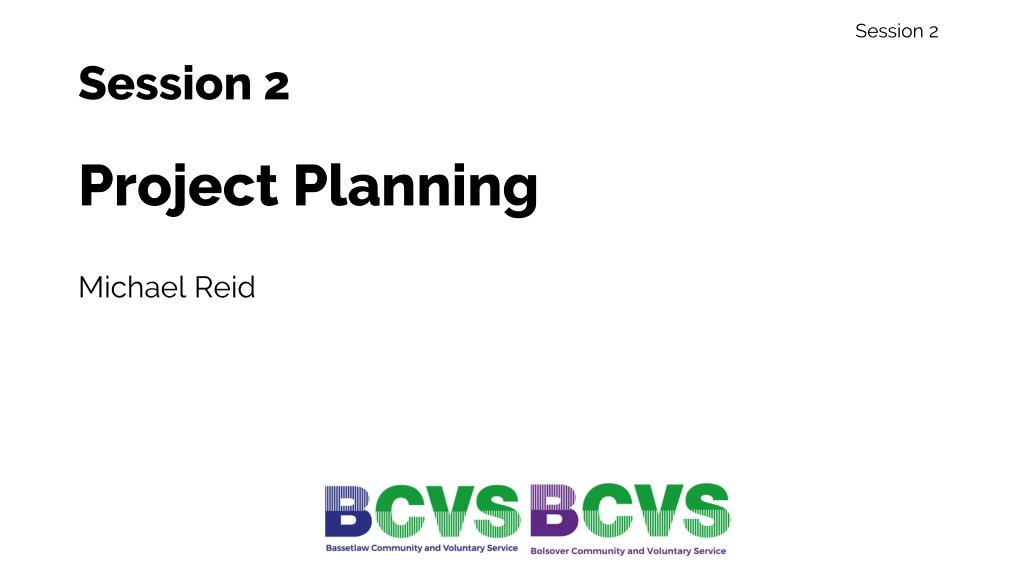
Project Planning Essentials and Challenges
Delve into the key aspects of project planning, including scope management, the Iron Triangle, schedule management, work breakdown structure, risks, and issues. Learn about scope creep, the Iron Triangle's components (Time, Cost, Quality), and the benefits of effective risk management in project execution. Gain insights into creating work breakdown structures and understanding the importance of managing project scope to ensure successful outcomes.
Uploaded on | 0 Views
Download Presentation

Please find below an Image/Link to download the presentation.
The content on the website is provided AS IS for your information and personal use only. It may not be sold, licensed, or shared on other websites without obtaining consent from the author. If you encounter any issues during the download, it is possible that the publisher has removed the file from their server.
You are allowed to download the files provided on this website for personal or commercial use, subject to the condition that they are used lawfully. All files are the property of their respective owners.
The content on the website is provided AS IS for your information and personal use only. It may not be sold, licensed, or shared on other websites without obtaining consent from the author.
E N D
Presentation Transcript
Session 2 Session 2 Project Planning Michael Reid
Session 2 Session 1 Recap Short Quiz Answers 1 B 2 C 3 A 4 C 5 C 10 A 6 C 7 B 8 B 9 C
Session 2 Project Planning Scope and the Project management triangle Schedule Management including Gantt Charts Risks and Issues Quality Procurement Change & control measures Communication Information and reporting requirements Health & Safety
Scope Session 2 What is (and is not) included in the project and its deliverables Should be clearly set out at the beginning of project initiation Project managers need to be aware of scope creep throughout the project lifecycle and should consider this as a risk. It is ubiquitous Scope creep will affect the Iron Triangle and therefore will usually need approval from the project board Scope Creep is the adding of features and functionality (project scope) without addressing the effects on time, costs, and resources, or without customer approval. Source: What does Scope Creep mean? Project Management Dictionary of Terms https://www.stakeholdermap.com/project-dictionary/scope-creep-meaning.html
Session 2 The Iron Triangle - The Triple Constraint Time Cost Quality
Schedule Management Session 2
Schedule Management Session 2
Session 2 Schedule Management Work Breakdown Structure (WBS)
Session 2 Schedule Management A completed work breakdown structure will help to develop the Gantt chart Have a go at completing a basic WBS for the design and delivery of a new course, planning a large event, new building or a new way of working within your service. What is the Parent Task? What are the child tasks? What are the sub-tasks and the work associated with each of these?
Session 2 Risks and Issues What are the benefits of risk management? Enables better informed and more believable plans, schedules and budgets Increases the likelihood of a project adhering to its schedules and budgets Allows a more meaningful assessment and justification of contingencies Discourages the acceptance of financially unsound projects Helps develop the ability of staff to assess risks Facilitates greater risk taking and increases the benefits gained.
Session 2 Risks and Issues What are project risks? The likelihood of an unanticipated event that could affect the project. What is risk mitigation? The ideal response to potential risks that might arise within a project. How do we manage these risks? Through good risk and issue management.
Session 2 Risk Management Process Initiate through the risk management plan Identification through the risk register see next slide Analysis risk reports as appropriate Response risk response plan as appropriate Closure lessons learned
Session 2 Identifying Risks Assumptions and constraints analysis Brainstorming Checklists Prompt Lists SWOT Analysis Think about proactive and reactive approaches to risk management
Session 2 Identifying Risks Can you share with the group a time where good risk management prevented or mitigated issues?
Session 2 Identifying Risks For your project what are the risks? Consider: Staffing Delivery Health and Safety Governance Reputation Scope creep Finance/Budget/Funding Political landscape Time/slippage/prioritisation Accountability of project members
Session 2 Issues An issue occurs when a problem that is immediate, or is about to occur, will breach accepted tolerances This may be foreseen (as part of the risk register) or unforeseen The issue may require support from the project sponsor to agree a resolution Issues are different to problems. Problems are usually dealt with by the project manager on a day-to-day basis Issues should be recorded using an 'issues log'
Session 2 Issue Management Log Example of an issues log
Session 2 Quality Management What is quality and quality management? What does quality look like? Is there a shared understanding? Are there varying degrees of quality or is there a pass/fail test? Often for product-based projects Can be used in other environments such as customer/user experience Consider from the outset how this will be managed and measured
Session 2 Communication Planning 90% of project management is communication true or false?
Session 2 Communication Planning A communication plan can be really useful Consider efficiency and effectiveness of the message What types of communication methods do you rely on the most? Why?
Session 2 Information and Reporting Good information management will lead to efficient reporting Consider what will be collected from the outset What will be reported? Performance Schedule Cost Quality Risk exposure Exception thresholds Collection Storage Curation Dissemination Archiving Destruction
Session 2 Procurement The process by which products and services are acquired from an external provider for incorporation into the project Consider the: Complexity of the work Capability of the team Appetite for risk Life cycle approach taken Make or buy decision Single or multiple suppliers Conditions and forms of contract Supplier reimbursement Contractual relationships Supplier selection process
Session 2 Procurement Supplier Selection Research Pre-qualification Tender Award Manage Close Be aware of Uk and organisation procurement policy, including procurement thresholds Changes to Public Procurement Thresholds (geldards.com) If unsure - take advice
Session 2 Change Control Usually, there will be changes in a project, some small and some big Changes will usually affect multiple stakeholders and members of the project team Changes need to be carefully considered, may involve an element of consultation and will need to be communicated properly You may have examples from your own projects where changes were not communicated effectively. What was the impact of this and how could it have been prevented? In formal project management, there should be a change log, outlining the specifics of the change, approval status and action steps
Session 2 Change Control
Session 2 Health and Safety Health and safety policy of the organisation Insurance status Risk assessment of work packages Staff training PPE (Personal protective equipment) Environmental impact Procured expertise where appropriate Health and Safety at Work Act
Session 2 Assessing Health and Safety Risk

